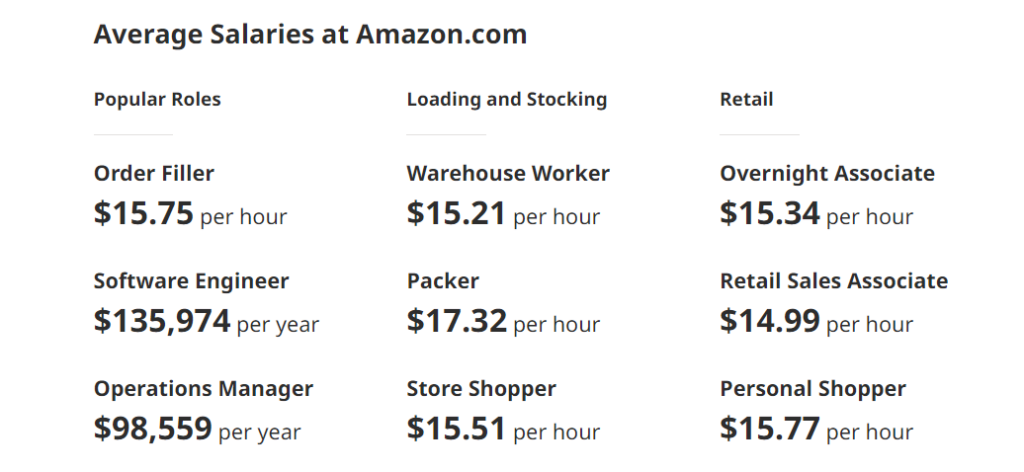Variation 1: Imagine earning a jaw-dropping $28,466 per hour. Sounds like the stuff of dreams, right? Well, for one lucky individual at Amazon, this unimaginable pay rate became a reality.
Wait… hold on! Before you start furiously updating your resume and rushing to apply for a job at the e-commerce giant, let’s dive into the nitty-gritty details of how much Amazon actually pays its employees per hour. Prepare to be surprised!
Minimum Wage:
Amazon’s starting pay rate has been the subject of much debate and scrutiny in recent years.
While some argue that the company should be commended for its decision to raise its minimum wage to $15 per hour, others argue that this is still not enough to support a decent standard of living.
It’s important to consider the geographic location and cost of living when discussing wages, as what may be a fair wage in one area could be barely enough to get by in another.
- One fresh perspective to consider is how Amazon’s starting pay rate compares to other big retailers. Walmart, for example, currently has a starting wage of $11 per hour.
- While Amazon’s $15 per hour may seem like a significant improvement in comparison, it is crucial to remember that both companies are multimillion-dollar corporations with billions in profits each year.
- Some argue that these companies have the ability and responsibility to further increase their minimum wages so employees can earn a more livable income.
- Another point worth discussing is how Amazon’s starting pay rate impacts its workforce and turnover rates.
- With such high demand for workers during peak seasons like Prime Day or the holiday season, offering competitive wages can incentivize employees to stay with the company longer.
- On the other hand, some argue that by focusing on higher starting pay rates instead of improving overall workplace conditions or providing better benefits, companies like Amazon fail to address systematic issues within their organizations.
Wage Increases:
Advancement opportunities and pay raises are two essential aspects of any job that employees value greatly. They not only provide a sense of achievement but also contribute to financial stability and personal growth.
In the case of Amazon, known for its vast scope of employment opportunities, these factors play a significant role in attracting and retaining a talented workforce.
With the company’s commitment to investing in employee development, there are numerous pathways for career progression within various departments or even across different roles.
Moreover, with Amazon’s recent decision to increase its minimum wage to $15 per hour, employees have been presented with an even greater incentive for advancement.
While this raise affects entry-level positions directly, it can indirectly benefit those higher up on the ladder as well.
An increase in base pay often leads to incremental adjustments throughout the pay scale, ensuring that all employees are compensated fairly according to their seniority and skill levels.
Overall, Amazon’s focus on providing advancement opportunities and consistent wage increases creates an environment conducive to employee satisfaction and motivation.
By recognizing and rewarding their hard work through promotions or monetary recognition, the company fosters a loyal and motivated workforce that is willing to go above and beyond expectations.
This investment in employee development ultimately benefits both parties involved – allowing individuals to grow professionally while contributing significantly towards Amazon’s continued success as an industry leader.
Additional Compensation:
When it comes to compensation, there’s more to consider than just hourly wages. Many companies offer additional benefits and bonuses as part of their overall package.
Amazon is no exception, providing a range of enticing perks that go beyond the paycheck.
- One significant benefit offered by Amazon is its comprehensive healthcare coverage. Employees have access to medical, dental, and vision insurance plans, ensuring that their health needs are taken care of.
- This not only provides peace of mind but also helps alleviate financial burdens associated with healthcare expenses.
- In addition to healthcare coverage, Amazon also offers generous retirement savings programs. Employees can participate in the 401(k) plan and receive a company match on their contributions.
- This means that for every dollar an employee invests in their retirement fund, Amazon will match a certain percentage up to a certain limit. This type of program encourages long-term saving habits and can significantly contribute to an employee’s financial security down the line.
- But it doesn’t stop there – Amazon takes further steps by recognizing exceptional performance through various bonus structures.
- These incentives provide employees with opportunities to earn extra income based on individual and team achievements. Bonuses could be awarded based on factors like meeting performance targets or exceeding customer satisfaction goals.
While hourly pay is important when considering employment options, it’s crucial not to overlook the additional compensation offered through benefits and bonuses.
These extras can greatly enhance an employee’s overall financial well-being and job satisfaction while cementing their commitment to the company they work for – which is something Amazon understands well.
Criticisms And Controversies Surrounding Amazon’s Pay
- One of the major criticisms surrounding Amazon’s pay is the allegation that it is not enough for its workers to live on.
- Many advocates argue that the company’s minimum wage of $15 per hour falls short, particularly in areas with high costs of living.
- Despite this seemingly competitive rate compared to the federal minimum wage of $7.25, activists argue that it is not a living wage and fails to adequately address employees’ needs.
- Additionally, controversy surrounds reports of poor working conditions within Amazon fulfillment centers. Critics often point out long hours, physically demanding tasks, and limited breaks as sources of concern.
- Some workers have even shared stories about having to urinate in bottles due to strict productivity quotas that prevent them from taking adequate restroom breaks.
- These testimonies have fuelled public outrage and sparked debates regarding worker treatment and fair compensation within the company.
While Amazon has made efforts to address some criticisms by increasing wages and providing additional benefits such as healthcare coverage, these issues persist and continue to be points of contention for many critics.
As discussions around income inequality gain traction globally, ending controversies related to low pay will likely remain a significant challenge for one of the world’s largest employers.
Conclusion:
In conclusion, when assessing Amazon’s hourly pay, it is evident that the company has been under scrutiny for its treatment of workers.
While Amazon claims to prioritize its employees’ well-being, reports of harsh working conditions and low wages raise concerns.
The recent increase in minimum wage to $15 per hour can be seen as a step in the right direction, but critics argue that it does not adequately address other issues such as unpredictable schedules and limited advancement opportunities.
However, it is important to note that Amazon’s hourly pay is not uniform across all positions. Some employees enjoy higher wages due to specialized skills or roles within the company.
Additionally, Amazon offers a range of benefits to its workers, including health insurance and retirement plans, which add value beyond just the hourly rate.
Overall, while Amazon’s hourly pay has become subject to much debate and criticism, understanding the broader context is necessary for a comprehensive assessment.
It is crucial for companies like Amazon to continually evaluate their compensation strategies in order to ensure fair treatment and sustainable growth for their workforce.






Be First to Comment